

Compact Muon Solenoid
LHC, CERN
| CMS-HIG-21-010 ; CERN-EP-2022-125 | ||
| Search for a charged Higgs boson decaying into a heavy neutral Higgs boson and a W boson in proton-proton collisions at $\sqrt{s} = $ 13 TeV | ||
| CMS Collaboration | ||
| 4 July 2022 | ||
| JHEP 09 (2023) 032 | ||
| Abstract: A search for a charged Higgs boson ${\mathrm{\tilde{H}^{\pm}}}$ decaying into a heavy neutral Higgs boson H and a W boson is presented. The analysis targets the H decay into a pair of tau leptons with at least one of them decaying hadronically and with an additional electron or muon present in the event. The search is based on proton-proton collision data recorded by the CMS experiment during 2016-2018 at $\sqrt{s} = $ 13 TeV, corresponding to an integrated luminosity of 138 fb$^{-1}$. The data are consistent with standard model background expectations. Upper limits at 95% confidence level are set on the product of the cross section and branching fraction for an ${\mathrm{\tilde{H}^{\pm}}}$ in the mass range of 300-700 GeV, assuming an H with a mass of 200 GeV. The observed limits range from 0.085 pb for an ${\mathrm{\tilde{H}^{\pm}}}$ mass of 300 GeV to 0.019 pb for a mass of 700 GeV. These are the first limits on ${\mathrm{\tilde{H}^{\pm}}}$ production in the ${\mathrm{\tilde{H}^{\pm}}} \to \mathrm{H} \mathrm{W^{\pm}}$ decay channel at the LHC. | ||
| Links: e-print arXiv:2207.01046 [hep-ex] (PDF) ; CDS record ; inSPIRE record ; HepData record ; CADI line (restricted) ; | ||
| Figures | |

png pdf |
Figure 1:
Leading order Feynman diagrams for the production of a heavy $\mathrm{H} ^{+}$ at the LHC through ${{\mathrm{p}} {\mathrm{p}} \to \mathrm{t} (\mathrm{b}) \mathrm{H} ^{+}}$ in the 4FS (left) and 5FS (right). |
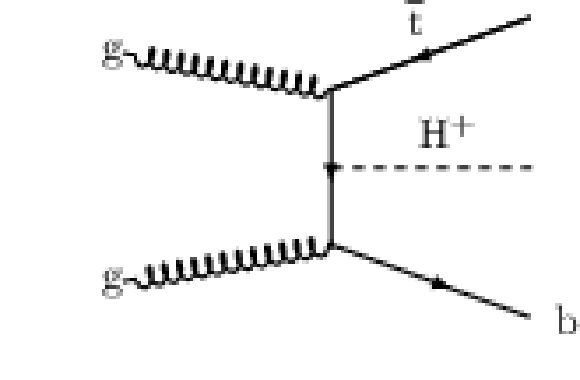
png pdf |
Figure 1-a:
Leading order Feynman diagram for the production of a heavy $\mathrm{H} ^{+}$ at the LHC through ${{\mathrm{p}} {\mathrm{p}} \to \mathrm{t} (\mathrm{b}) \mathrm{H} ^{+}}$ in the 4FS. |
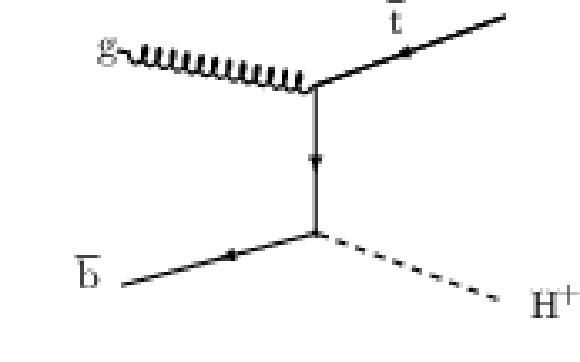
png pdf |
Figure 1-b:
Leading order Feynman diagram for the production of a heavy $\mathrm{H} ^{+}$ at the LHC through ${{\mathrm{p}} {\mathrm{p}} \to \mathrm{t} (\mathrm{b}) \mathrm{H} ^{+}}$ in the 5FS. |

png pdf |
Figure 2:
Feynman diagrams showing the signal processes targeted by this analysis, with the production of a heavy $\mathrm{H} ^{+}$ in the 4FS, followed by the ${\mathrm{H} ^{+} \to \mathrm{H} \mathrm{W} ^{+}}$ and ${\mathrm{H} \to \tau \tau}$ decays, resulting in ${\ell {\tau _\mathrm {h}}}$ (left) and ${\ell {\tau _\mathrm {h}} {\tau _\mathrm {h}}}$ (right) final states. Contributions to the ${\ell {\tau _\mathrm {h}}}$ final state may also arise from the right diagram when one ${\tau _\mathrm {h}}$ from the ${\mathrm{H} \to \tau \tau}$ decay is not reconstructed. |
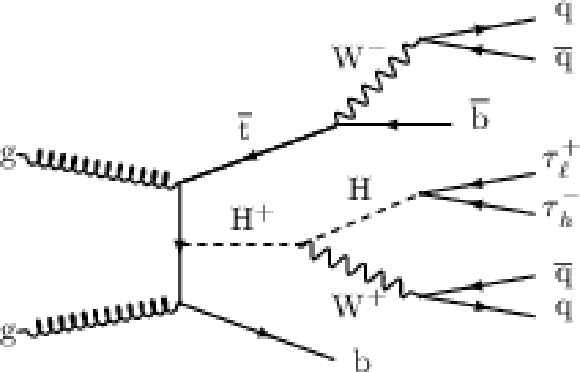
png pdf |
Figure 2-a:
Feynman diagram showing the signal processes targeted by this analysis, with the production of a heavy $\mathrm{H} ^{+}$ in the 4FS, followed by the ${\mathrm{H} ^{+} \to \mathrm{H} \mathrm{W} ^{+}}$ and ${\mathrm{H} \to \tau \tau}$ decays, resulting in the ${\ell {\tau _\mathrm {h}}}$ final state. |
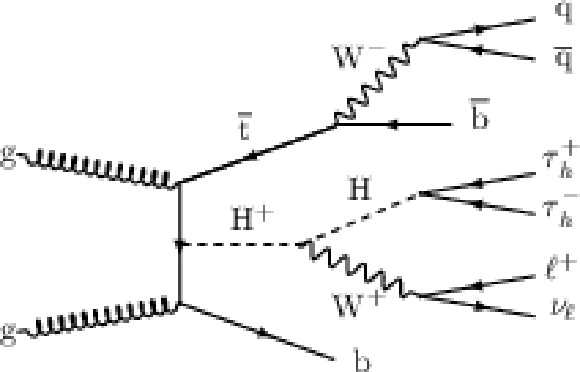
png pdf |
Figure 2-b:
Feynman diagram showing the signal processes targeted by this analysis, with the production of a heavy $\mathrm{H} ^{+}$ in the 4FS, followed by the ${\mathrm{H} ^{+} \to \mathrm{H} \mathrm{W} ^{+}}$ and ${\mathrm{H} \to \tau \tau}$ decays, resulting in the ${\ell {\tau _\mathrm {h}} {\tau _\mathrm {h}}}$ final state. |
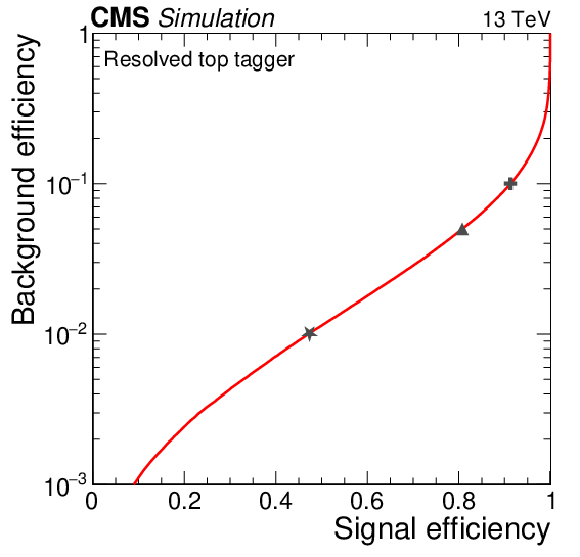
png pdf |
Figure 3:
Receiver operating characteristic curve of the ${\mathrm{t} ^{\text {res}}}$ tagger. The cross-, triangle-, and star-shaped markers indicate the loose, medium, and tight working points with 10, 5, and 1% background misidentification probability. The corresponding identification efficiencies are 91, 81, and 47%, respectively. |
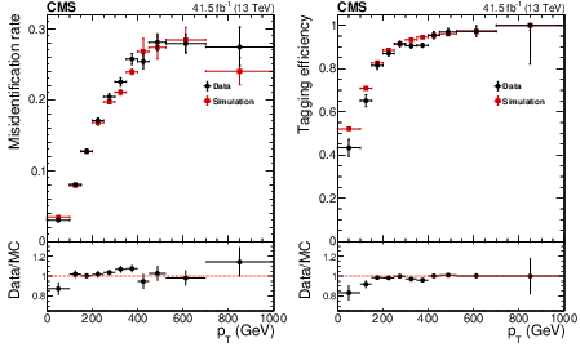
png pdf |
Figure 4:
Misidentification rate (left) and ${\mathrm{t} ^{\text {res}}}$-tagging efficiency (right) in data and simulation, as a function of the ${\mathrm{t} ^{\text {res}}}$ candidate ${p_{\mathrm {T}}}$ for the loose working point, using the 2017 data. |

png pdf |
Figure 4-a:
Misidentification rate in data and simulation, as a function of the ${\mathrm{t} ^{\text {res}}}$ candidate ${p_{\mathrm {T}}}$ for the loose working point, using the 2017 data. |

png pdf |
Figure 4-b:
${\mathrm{t} ^{\text {res}}}$-tagging efficiency in data and simulation, as a function of the ${\mathrm{t} ^{\text {res}}}$ candidate ${p_{\mathrm {T}}}$ for the loose working point, using the 2017 data. |

png pdf |
Figure 5:
Three of the BDTG input variables used for the $\mu{\tau_\mathrm{h}}$ final state, assuming a signal with mass ${m_{{\mathrm{\tilde{H}^{\pm}}}}} =$ 500 GeV and 2018 data-taking conditions: the azimuthal angle between the $\mu$ and ${\vec{p}_{\mathrm {T}}^{\,\text {miss}}}$ objects (top left), the ratio of the ${p_{\mathrm {T}}}$ of the third leading jet and the ${H_{\mathrm {T}}}$ (top right), and the transverse mass reconstructed from the $\mu$, ${\tau _\mathrm {h}}$, $j_{1}$, $j_{2}$, and ${\vec{p}_{\mathrm {T}}^{\,\text {miss}}}$ objects (bottom). Both signal and background distributions are normalized to unit area. |
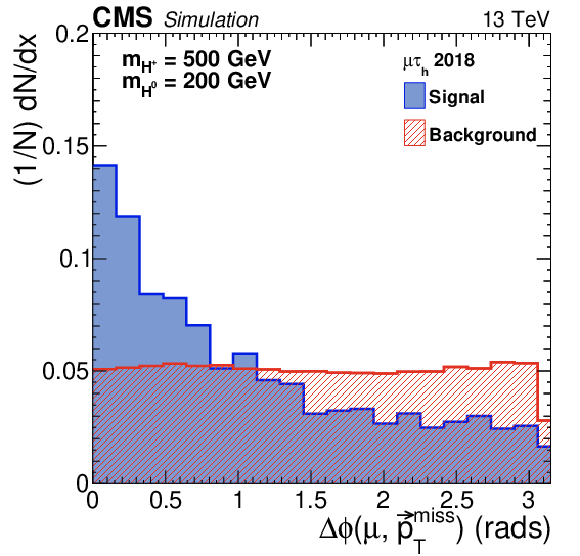
png pdf |
Figure 5-a:
The azimuthal angle between the $\mu$ and ${\vec{p}_{\mathrm {T}}^{\,\text {miss}}}$ objects, which is one of the BDTG input variables used for the $\mu{\tau_\mathrm{h}}$ final state, assuming a signal with mass ${m_{{\mathrm{\tilde{H}^{\pm}}}}} =$ 500 GeV and 2018 data-taking conditions. Both signal and background distributions are normalized to unit area. |

png pdf |
Figure 5-b:
The ratio of the ${p_{\mathrm {T}}}$ of the third leading jet and the ${H_{\mathrm {T}}}$, which is one of the BDTG input variables used for the $\mu{\tau_\mathrm{h}}$ final state, assuming a signal with mass ${m_{{\mathrm{\tilde{H}^{\pm}}}}} =$ 500 GeV and 2018 data-taking conditions. Both signal and background distributions are normalized to unit area. |

png pdf |
Figure 5-c:
The transverse mass reconstructed from the $\mu$, ${\tau _\mathrm {h}}$, $j_{1}$, $j_{2}$, and ${\vec{p}_{\mathrm {T}}^{\,\text {miss}}}$ objects, which is one of the BDTG input variables used for the $\mu{\tau_\mathrm{h}}$ final state, assuming a signal with mass ${m_{{\mathrm{\tilde{H}^{\pm}}}}} =$ 500 GeV and 2018 data-taking conditions. Both signal and background distributions are normalized to unit area. |

png pdf |
Figure 6:
The MVA output of the BDTG for the e${\tau_\mathrm{h}}$ (left) and $\mu{\tau_\mathrm{h}}$ (right) final states used in the limit extraction, after a background-only fit to the data. The data sets of all categories have been added. The pre-fit contribution from ${{\mathrm{\tilde{H}^{\pm}}} \to \mathrm{H} \mathrm{W^{\pm}}}$ with masses ${m_{{\mathrm{\tilde{H}^{\pm}}}}} =$ 500 GeV and $ {m_{\mathrm{H}}} = $ 200 GeV and $ {\sigma _{{\mathrm{\tilde{H}^{\pm}}}} {\mathcal {B}({{\mathrm{\tilde{H}^{\pm}}} \to \mathrm{H} \mathrm{W^{\pm}}}, {\mathrm{H} \to \tau \tau})}} = $ 1 pb is also shown. |
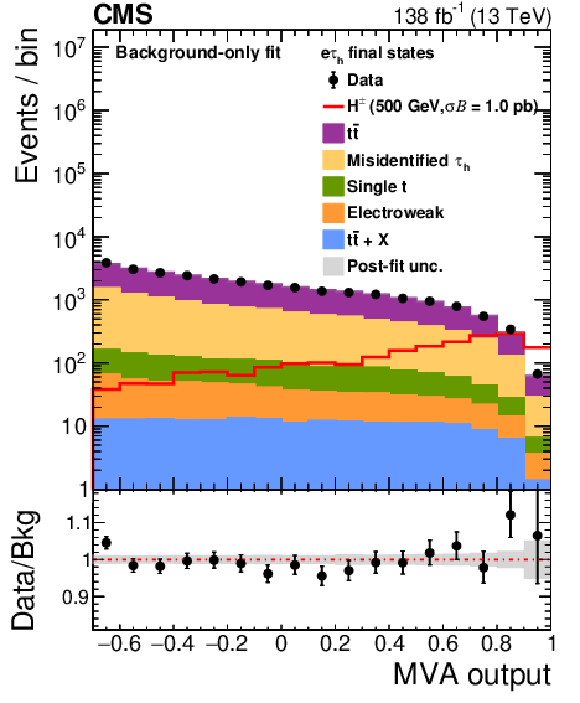
png pdf |
Figure 6-a:
The MVA output of the BDTG for the e${\tau_\mathrm{h}}$ final state used in the limit extraction, after a background-only fit to the data. The data sets of all categories have been added. The pre-fit contribution from ${{\mathrm{\tilde{H}^{\pm}}} \to \mathrm{H} \mathrm{W^{\pm}}}$ with masses ${m_{{\mathrm{\tilde{H}^{\pm}}}}} =$ 500 GeV and $ {m_{\mathrm{H}}} = $ 200 GeV and $ {\sigma _{{\mathrm{\tilde{H}^{\pm}}}} {\mathcal {B}({{\mathrm{\tilde{H}^{\pm}}} \to \mathrm{H} \mathrm{W^{\pm}}}, {\mathrm{H} \to \tau \tau})}} = $ 1 pb is also shown. |
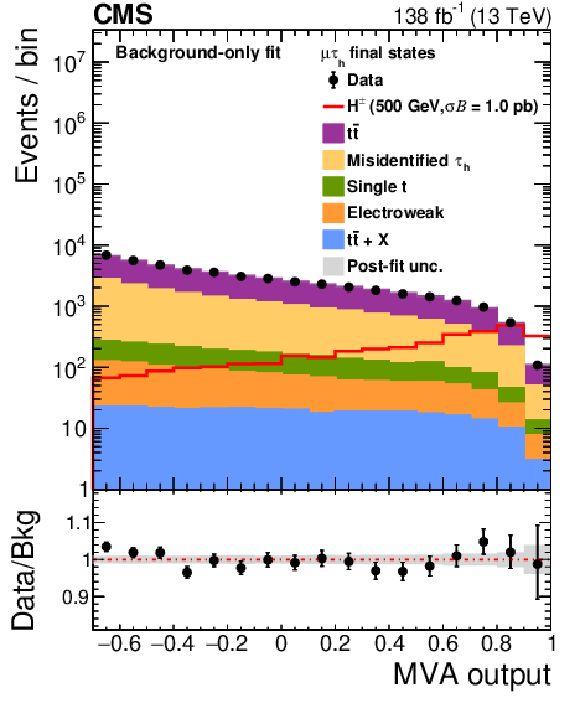
png pdf |
Figure 6-b:
The MVA output of the BDTG for the $\mu{\tau_\mathrm{h}}$ final state used in the limit extraction, after a background-only fit to the data. The data sets of all categories have been added. The pre-fit contribution from ${{\mathrm{\tilde{H}^{\pm}}} \to \mathrm{H} \mathrm{W^{\pm}}}$ with masses ${m_{{\mathrm{\tilde{H}^{\pm}}}}} =$ 500 GeV and $ {m_{\mathrm{H}}} = $ 200 GeV and $ {\sigma _{{\mathrm{\tilde{H}^{\pm}}}} {\mathcal {B}({{\mathrm{\tilde{H}^{\pm}}} \to \mathrm{H} \mathrm{W^{\pm}}}, {\mathrm{H} \to \tau \tau})}} = $ 1 pb is also shown. |
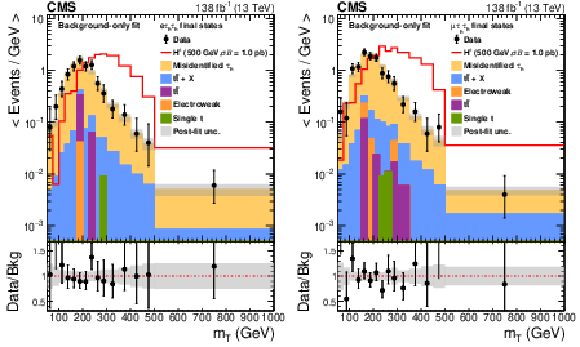
png pdf |
Figure 7:
The ${m_{\mathrm {T}}}$ distributions for the e${\tau_\mathrm{h}}{\tau_\mathrm{h}}$ (left) and $\mu{\tau_\mathrm{h}}{\tau_\mathrm{h}}$ (right) final states used in the limit extraction, after a background-only fit to the data. The data sets of all categories have been added. The pre-fit contribution from ${{\mathrm{\tilde{H}^{\pm}}} \to \mathrm{H} \mathrm{W^{\pm}}}$ with masses ${m_{{\mathrm{\tilde{H}^{\pm}}}}} =$ 500 GeV and $ {m_{\mathrm{H}}} = $ 200 GeV and $ {\sigma _{{\mathrm{\tilde{H}^{\pm}}}} {\mathcal {B}({{\mathrm{\tilde{H}^{\pm}}} \to \mathrm{H} \mathrm{W^{\pm}}}, {\mathrm{H} \to \tau \tau})}} = $ 1 pb is also shown. The brackets $ \langle \cdot \rangle $ signify that the plotted variable is averaged over an interval in which the event frequency may have changed considerably. |

png pdf |
Figure 7-a:
The ${m_{\mathrm {T}}}$ distributions for the e${\tau_\mathrm{h}}{\tau_\mathrm{h}}$ final state used in the limit extraction, after a background-only fit to the data. The data sets of all categories have been added. The pre-fit contribution from ${{\mathrm{\tilde{H}^{\pm}}} \to \mathrm{H} \mathrm{W^{\pm}}}$ with masses ${m_{{\mathrm{\tilde{H}^{\pm}}}}} =$ 500 GeV and $ {m_{\mathrm{H}}} = $ 200 GeV and $ {\sigma _{{\mathrm{\tilde{H}^{\pm}}}} {\mathcal {B}({{\mathrm{\tilde{H}^{\pm}}} \to \mathrm{H} \mathrm{W^{\pm}}}, {\mathrm{H} \to \tau \tau})}} = $ 1 pb is also shown. The brackets $ \langle \cdot \rangle $ signify that the plotted variable is averaged over an interval in which the event frequency may have changed considerably. |

png pdf |
Figure 7-b:
The ${m_{\mathrm {T}}}$ distributions for the $\mu{\tau_\mathrm{h}}{\tau_\mathrm{h}}$ final state used in the limit extraction, after a background-only fit to the data. The data sets of all categories have been added. The pre-fit contribution from ${{\mathrm{\tilde{H}^{\pm}}} \to \mathrm{H} \mathrm{W^{\pm}}}$ with masses ${m_{{\mathrm{\tilde{H}^{\pm}}}}} =$ 500 GeV and $ {m_{\mathrm{H}}} = $ 200 GeV and $ {\sigma _{{\mathrm{\tilde{H}^{\pm}}}} {\mathcal {B}({{\mathrm{\tilde{H}^{\pm}}} \to \mathrm{H} \mathrm{W^{\pm}}}, {\mathrm{H} \to \tau \tau})}} = $ 1 pb is also shown. The brackets $ \langle \cdot \rangle $ signify that the plotted variable is averaged over an interval in which the event frequency may have changed considerably. |
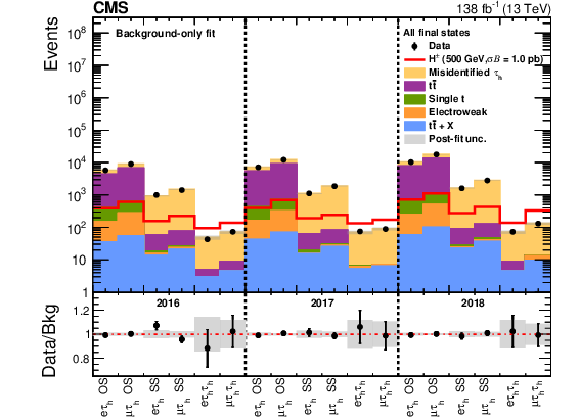
png pdf |
Figure 8:
Observed event yields (black markers) for the 18 categories considered in this analysis, grouped into data sets that are represented by vertical dashed lines. The expected event yields (stacked histograms) resulting from a background-only fit to the data are also shown, broken down into various background processes. The solid red line represents the expected signal yields from ${{\mathrm{\tilde{H}^{\pm}}} \to \mathrm{H} \mathrm{W^{\pm}}}$ with masses ${m_{{\mathrm{\tilde{H}^{\pm}}}}} =$ 500 GeV and $ {m_{\mathrm{H}}} = $ 200 GeV, assuming $ {\sigma _{{\mathrm{\tilde{H}^{\pm}}}} {\mathcal {B}({{\mathrm{\tilde{H}^{\pm}}} \to \mathrm{H} \mathrm{W^{\pm}}}, {\mathrm{H} \to \tau \tau})}} = $ 1 pb. |

png pdf |
Figure 9:
Expected and observed upper limits at 95% CL on the product of cross section and branching fraction ${\sigma _{{\mathrm{\tilde{H}^{\pm}}}} {\mathcal {B}({{\mathrm{\tilde{H}^{\pm}}} \to \mathrm{H} \mathrm{W^{\pm}}}, {\mathrm{H} \to \tau \tau})}}$ as a function of ${m_{{\mathrm{\tilde{H}^{\pm}}}}}$ and assuming $ {m_{\mathrm{H}}} = $ 200 GeV for the combination of all final states considered (left). The observed upper limits are represented by a solid black line and circle markers. The median expected limit (dashed line), 68% (inner green band), and 95% (outer yellow band) confidence intervals are also shown. The relative expected contributions of each final state to the overall combination are also presented (right). The black solid line corresponds to the combined expected limit, while the red dash-dotted, green dashed, blue dashed-dotted, and orange dashed lines represent the relative contributions from the e${\tau_\mathrm{h}}$, $\mu{\tau_\mathrm{h}}$, e${\tau_\mathrm{h}}{\tau_\mathrm{h}}$, and $\mu{\tau_\mathrm{h}}{\tau_\mathrm{h}}$ channels, respectively. |

png pdf |
Figure 9-a:
Expected and observed upper limits at 95% CL on the product of cross section and branching fraction ${\sigma _{{\mathrm{\tilde{H}^{\pm}}}} {\mathcal {B}({{\mathrm{\tilde{H}^{\pm}}} \to \mathrm{H} \mathrm{W^{\pm}}}, {\mathrm{H} \to \tau \tau})}}$ as a function of ${m_{{\mathrm{\tilde{H}^{\pm}}}}}$ and assuming $ {m_{\mathrm{H}}} = $ 200 GeV for the combination of all final states considered. The observed upper limits are represented by a solid black line and circle markers. The median expected limit (dashed line), 68% (inner green band), and 95% (outer yellow band) confidence intervals are also shown. |

png pdf |
Figure 9-b:
The relative expected contributions of each final state to the overall combination are also presented. The black solid line corresponds to the combined expected limit, while the red dash-dotted, green dashed, blue dashed-dotted, and orange dashed lines represent the relative contributions from the e${\tau_\mathrm{h}}$, $\mu{\tau_\mathrm{h}}$, e${\tau_\mathrm{h}}{\tau_\mathrm{h}}$, and $\mu{\tau_\mathrm{h}}{\tau_\mathrm{h}}$ channels, respectively. |
| Tables | |

png pdf |
Table 1:
Offline selections applied to the reconstructed objects to obtain the SRs of the ${\ell {\tau _\mathrm {h}}}$ and ${\ell {\tau _\mathrm {h}} {\tau _\mathrm {h}}}$ final states. The ${p_{\mathrm {T}}}$, ${{p_{\mathrm {T}}} ^\text {miss}}$, and ${S_{\mathrm {T}}}$ variables are reported in units of GeV, and ${Q_{}}$ in units of $e$. Selection criteria that depend on the year of data taking are presented in parentheses with the order corresponding to (2016, 2017, 2018). The symbol $\star $ is used to represent an electron (muon) for the e${\tau_\mathrm{h}}$ ( $\mu{\tau_\mathrm{h}}$) final states, and a ${\tau _\mathrm {h}}$ object in the e${\tau_\mathrm{h}}{\tau_\mathrm{h}}$ and $\mu{\tau_\mathrm{h}}{\tau_\mathrm{h}}$ final states. |

png pdf |
Table 2:
Offline selections applied to the reconstructed objects to obtain the CRs and VRs for the misidentified ${\tau _\mathrm {h}}$ candidate background estimation in the ${\ell {\tau _\mathrm {h}}}$ and ${\ell {\tau _\mathrm {h}} {\tau _\mathrm {h}}}$ final states. Only differences with respect to the corresponding SRs are shown. The ${p_{\mathrm {T}}}$, ${{p_{\mathrm {T}}} ^\text {miss}}$, and ${S_{\mathrm {T}}}$ variables are reported in units of GeV, and ${Q_{}}$ in units of $e$. The symbol $\star $ is used to represent an electron (muon) for the e${\tau_\mathrm{h}}$ ( $\mu{\tau_\mathrm{h}}$) final states, and a ${\tau _\mathrm {h}}$ object in the e${\tau_\mathrm{h}}{\tau_\mathrm{h}}$ and $\mu{\tau_\mathrm{h}}{\tau_\mathrm{h}}$ final states. |

png pdf |
Table 3:
The complete set of discriminating variables used in the training of the BDTG classifier employed in the search strategy of the ${\ell {\tau _\mathrm {h}}}$ final states. |

png pdf |
Table 4:
Summary of all sources of systematic uncertainties discussed in the text. The first column identifies the source of uncertainty and, where applicable, the process that it applies to. The second column indicates with a check mark or dash whether or not the nuisance parameter also affects the shape of the fit discriminant. The third column, which is subdivided into four event categories, presents the percentage impact of these nuisance parameters on the expected event yields, before simultaneous fitting the data for the background-only hypothesis. A range of such values represents the minimum and maximum values observed through the different samples and data eras, with apparent disparities also attributed to the limited sample size of minor backgrounds. The last two columns indicate whether or not the nuisance parameters are correlated across years and categories. A dagger designates that a nuisance parameter is only partially correlated across years or categories. |
| Summary |
| Results are presented from a search for a charged Higgs boson ${\mathrm{\tilde{H}^{\pm}}}$ decaying into a heavy neutral Higgs boson H and a W boson. Events are selected with exactly one isolated electron or muon, targeting event topologies whereby the H decays into a pair of tau leptons with at least one decaying hadronically (${\tau_\mathrm{h}}$). Four distinct final states are considered: e${\tau_\mathrm{h}}$, $\mu{\tau_\mathrm{h}}$, e${\tau_\mathrm{h}}{\tau_\mathrm{h}}$, and $\mu{\tau_\mathrm{h}}{\tau_\mathrm{h}}$. The analysis uses proton-proton collision data recorded by the CMS detector at $\sqrt{s} = $ 13 TeV, corresponding to an integrated luminosity of 138 fb$^{-1}$. No significant deviation is observed from standard model expectations. Upper limits at 95% confidence level are set on the product of the cross section and branching fraction for an ${\mathrm{\tilde{H}^{\pm}}}$ in the mass range of 300-700 GeV, assuming an H with a mass of 200 GeV. The observed limits range from 0.085 pb for an ${\mathrm{\tilde{H}^{\pm}}}$ mass of 300 GeV to 0.019 pb for a mass of 700 GeV. These are the first limits on ${\mathrm{\tilde{H}^{\pm}}}$ production in the ${\mathrm{\tilde{H}^{\pm}}} \to \mathrm{H} \mathrm{W^{\pm}}$ decay channel at the LHC. |
| References | ||||
| 1 | P. W. Higgs | Broken symmetries, massless particles and gauge fields | PL12 (1964) 132 | |
| 2 | P. W. Higgs | Broken symmetries and the masses of gauge bosons | PRL 13 (1964) 508 | |
| 3 | G. S. Guralnik, C. R. Hagen, and T. W. B. Kibble | Global conservation laws and massless particles | PRL 13 (1964) 585 | |
| 4 | F. Englert and R. Brout | Broken symmetry and the mass of gauge vector mesons | PRL 13 (1964) 321 | |
| 5 | P. W. Higgs | Spontaneous symmetry breakdown without massless bosons | PR145 (1966) 1156 | |
| 6 | T. W. B. Kibble | Symmetry breaking in non-Abelian gauge theories | PR155 (1967) 1554 | |
| 7 | ATLAS Collaboration | Observation of a new particle in the search for the standard model Higgs boson with the ATLAS detector at the LHC | PLB 716 (2012) 1 | 1207.7214 |
| 8 | CMS Collaboration | Observation of a new boson at a mass of 125 GeV with the CMS experiment at the LHC | PLB 716 (2012) 30 | CMS-HIG-12-028 1207.7235 |
| 9 | CMS Collaboration | Observation of a new boson with mass near 125 GeV in pp collisions at $ \sqrt{s} = $ 7 and 8 TeV | JHEP 06 (2013) 081 | CMS-HIG-12-036 1303.4571 |
| 10 | ATLAS and CMS Collaborations | Measurements of the Higgs boson production and decay rates and constraints on its couplings from a combined ATLAS and CMS analysis of the LHC pp collision data at $ \sqrt{s} = $ 7 and 8 TeV | JHEP 08 (2016) 045 | 1606.02266 |
| 11 | CMS Collaboration | Combined measurements of Higgs boson couplings in proton-proton collisions at $ \sqrt{s} = $ 13 TeV | EPJC 79 (2019) 421 | CMS-HIG-17-031 1809.10733 |
| 12 | ATLAS Collaboration | Combined measurements of Higgs boson production and decay using up to 80 fb$^{-1}$ of proton-proton collision data at $ \sqrt{s} = $ 13 TeV collected with the ATLAS experiment | PRD 101 (2020) 012002 | 1909.02845 |
| 13 | CMS Collaboration | Measurements of the Higgs boson width and anomalous HVV couplings from on-shell and off-shell production in the four-lepton final state | PRD 99 (2019) 112003 | CMS-HIG-18-002 1901.00174 |
| 14 | J. F. Gunion and H. E. Haber | The CP conserving two Higgs doublet model: the approach to the decoupling limit | PRD 67 (2003) 075019 | hep-ph/0207010 |
| 15 | A. G. Akeroyd et al. | Prospects for charged Higgs searches at the LHC | EPJC 77 (2017) 276 | 1607.01320 |
| 16 | G. C. Branco et al. | Theory and phenomenology of two-Higgs-doublet models | PR 516 (2012) 1 | 1106.0034 |
| 17 | N. Craig and S. Thomas | Exclusive signals of an extended Higgs sector | JHEP 11 (2012) 083 | 1207.4835 |
| 18 | CMS Collaboration | A measurement of the Higgs boson mass in the diphoton decay channel | PLB 805 (2020) 135425 | CMS-HIG-19-004 2002.06398 |
| 19 | S. Dittmaier, M. Krämer, and M. Spira | Higgs radiation off bottom quarks at the Tevatron and the CERN LHC | PRD 70 (2004) 074010 | hep-ph/0309204 |
| 20 | S. Dawson, C. B. Jackson, L. Reina, and D. Wackeroth | Exclusive Higgs boson production with bottom quarks at hadron colliders | PRD 69 (2004) 074027 | hep-ph/0311067 |
| 21 | R. V. Harlander and W. B. Kilgore | Higgs boson production in bottom quark fusion at next-to-next-to leading order | PRD 68 (2003) 013001 | hep-ph/0304035 |
| 22 | R. Harlander, M. Kramer, and M. Schumacher | Bottom-quark associated Higgs-boson production: reconciling the four- and five-flavour scheme approach | 2011 | 1112.3478 |
| 23 | H. Bahl, T. Stefaniak, and J. Wittbrodt | The forgotten channels: charged Higgs boson decays to a W$^{\pm} $ and a non-SM-like Higgs boson | JHEP 06 (2021) | 2103.07484 |
| 24 | ATLAS Collaboration | Search for charged Higgs bosons decaying via $ {\mathrm{\tilde{H}^{\pm_j}}} \rightarrow \tau^{\pm}\nu $ in fully hadronic final states using pp collision data at $ \sqrt{s} = $ 8 TeV with the ATLAS detector | JHEP 03 (2015) 088 | 1412.6663 |
| 25 | CMS Collaboration | Search for a charged Higgs boson in pp collisions at $ \sqrt{s} = $ 8 TeV | JHEP 11 (2015) 018 | CMS-HIG-14-023 1508.07774 |
| 26 | ATLAS Collaboration | Search for charged Higgs bosons decaying via $ {{\mathrm{\tilde{H}^{\pm_j}}}} \to \tau^{\pm}\nu_{\tau} $ in the $ \tau $+jets and $ \tau $+lepton final states with 36$ fb$^{-1} of pp collision data recorded at $ \sqrt{s} = $ 13 TeV with the ATLAS experiment | JHEP 09 (2018) 139 | 1807.07915 |
| 27 | CMS Collaboration | Search for charged Higgs bosons in the $ {\mathrm{\tilde{H}^{\pm_j}}} \to \tau^{\pm}\nu_{\tau} $ decay channel in proton-proton collisions at $ \sqrt{s} = $ 13 TeV | JHEP 07 (2019) 142 | CMS-HIG-18-014 1903.04560 |
| 28 | CMS Collaboration | Search for a light charged Higgs boson decaying to $ \mathrm{c}\mathrm{\bar{s}} $ in pp collisions at $ \sqrt{s} = $ 8 TeV | JHEP 12 (2015) 178 | CMS-HIG-13-035 1510.04252 |
| 29 | ATLAS Collaboration | Search for a light charged Higgs boson in the decay channel $ \mathrm{H}^+ \to \mathrm{c}\mathrm{\bar{s}} $ in $ \mathrm{t\bar{t}} $ events using pp collisions at $ \sqrt{s} = $ 7 TeV with the ATLAS detector | EPJC 73 (2013) 2465 | 1302.3694 |
| 30 | CMS Collaboration | Search for a charged Higgs boson decaying to charm and bottom quarks in proton-proton collisions at $ \sqrt{s} = $ 8 TeV | JHEP 11 (2018) 115 | CMS-HIG-16-030 1808.06575 |
| 31 | CMS Collaboration | Search for a light charged Higgs boson decaying to a W boson and a CP-odd Higgs boson in final states with e$\mu\mu $ or $ \mu\mu\mu $ in proton-proton collisions at $ \sqrt{s} = $ 13 TeV | PRL 123 (2019) 131802 | CMS-HIG-18-020 1905.07453 |
| 32 | ATLAS Collaboration | Search for charged Higgs bosons in the $ {\mathrm{\tilde{H}^{\pm_j}}} \to \mathrm{t}\mathrm{b} $ decay channel in pp collisions at $ \sqrt{s} = $ 8 TeV using the ATLAS detector | JHEP 03 (2016) 127 | 1512.03704 |
| 33 | ATLAS Collaboration | Search for charged Higgs bosons decaying into top and bottom quarks at $ \sqrt{s} = $ 13 TeV with the ATLAS detector | JHEP 11 (2018) 085 | 1808.03599 |
| 34 | CMS Collaboration | Search for a charged Higgs boson decaying into top and bottom quarks in events with electrons or muons in proton-proton collisions at $ \sqrt{s} = $ 13 TeV | JHEP 01 (2020) 096 | CMS-HIG-18-004 1908.09206 |
| 35 | ATLAS Collaboration | Search for charged Higgs bosons produced in association with a top quark and decaying via $ {\mathrm{\tilde{H}^{\pm_j}}} \rightarrow \tau\nu $ using pp collision data recorded at $ \sqrt{s} = $ 13 TeV by the ATLAS detector | PLB 759 (2016) 555 | 1603.09203 |
| 36 | CMS Collaboration | Search for charged Higgs bosons decaying into a top and a bottom quark in the all-jet final state of pp collisions at $ \sqrt{s} = $ 13 TeV | JHEP 07 (2020) 126 | CMS-HIG-18-015 2001.07763 |
| 37 | BaBar and Belle Collaborations | The physics of the B factories | EPJC 74 (2014) 3026 | 1406.6311 |
| 38 | Belle II Collaboration | The Belle II Physics Book | PTEP 2019 (2019) 123C01 | 1808.10567 |
| 39 | G. Senjanovic and R. N. Mohapatra | Exact left-right symmetry and spontaneous violation of parity | PRD 12 (1975) 1502 | |
| 40 | J. F. Gunion, R. Vega, and J. Wudka | Higgs triplets in the standard model | PRD 42 (1990) 1673 | |
| 41 | H. Georgi and M. Machacek | Doubly charged Higgs bosons | NPB 262 (1985) 463 | |
| 42 | ATLAS Collaboration | Search for a charged Higgs boson produced in the vector-boson fusion mode with decay $ {\mathrm{\tilde{H}^{\pm_j}}} \to \mathrm{W^{\pm}} \mathrm{Z} $ using pp collisions at $ \sqrt{s}= $ 8 TeV with the ATLAS experiment | PRL 114 (2015) 231801 | 1503.04233 |
| 43 | CMS Collaboration | Search for charged Higgs bosons produced via vector boson fusion and decaying into a pair of W and $ \mathrm{Z} $ bosons using pp collisions at $ \sqrt{s} = $ 13 TeV | PRL 119 (2017) 141802 | CMS-HIG-16-027 1705.02942 |
| 44 | CMS Collaboration | Observation of electroweak production of same-sign W boson pairs in the two jet and two same-sign lepton final state in proton-proton collisions at $ \sqrt{s} = $ 13 TeV | PRL 120 (2018) 081801 | CMS-SMP-17-004 1709.05822 |
| 45 | CMS Collaboration | Search for charged Higgs bosons produced in vector boson fusion processes and decaying into vector boson pairs in proton-proton collisions at $ \sqrt{s} = $ 13 TeV | EPJC 81 (2021) 723 | CMS-HIG-20-017 2104.04762 |
| 46 | ATLAS Collaboration | Search for dijet resonances in events with an isolated charged lepton using $ \sqrt{s} = $ 13 TeV proton-proton collision data collected by the ATLAS detector | JHEP 06 (2020) 151 | 2002.11325 |
| 47 | DELPHI, OPAL, ALEPH, L3 and LEP Working Group for Higgs Boson Searches Collaboration | Search for neutral MSSM Higgs bosons at LEP | EPJC 47 (2006) 547 | hep-ex/0602042 |
| 48 | CDF Collaboration | Search for Higgs bosons predicted in Two-Higgs-Doublet models via decays to tau lepton pairs in $ 1.96 $ TeV $ {\mathrm{p}}\mathrm{\bar{p}} $ collisions | PRL 103 (2009) 201801 | 0906.1014 |
| 49 | D0 Collaboration | Search for neutral Higgs bosons in the multi-b-jet topology in 5.2 fb$^{-1}$ of $ {\mathrm{p}}\mathrm{\bar{p}} $ collisions at $ \sqrt{s} = $ 1.96 TeV | PLB 698 (2011) 97 | 1011.1931 |
| 50 | D0 Collaboration | Search for Higgs bosons decaying to $ \tau^{+}\tau^{-} $ pairs in $ {\mathrm{p}}\mathrm{\bar{p}} $ collisions at $ \sqrt{s} = $ 1.96 TeV | PLB 707 (2012) 323 | 1106.4555 |
| 51 | CDF Collaboration | Search for Higgs bosons produced in association with b-quarks | PRD 85 (2012) 032005 | 1106.4782 |
| 52 | CMS Collaboration | Search for a Higgs boson decaying into a b-quark pair and produced in association with b quarks in proton-proton collisions at 7 TeV | PLB 722 (2013) 207 | CMS-HIG-12-033 1302.2892 |
| 53 | CMS Collaboration | Search for neutral MSSM Higgs bosons decaying into a pair of bottom quarks | JHEP 11 (2015) 071 | CMS-HIG-14-017 1506.08329 |
| 54 | CMS Collaboration | Search for beyond the standard model Higgs bosons decaying into a $ \mathrm{b\bar{b}} $ pair in pp collisions at $ \sqrt{s} = $ 13 TeV | JHEP 08 (2018) 113 | CMS-HIG-16-018 1805.12191 |
| 55 | ATLAS Collaboration | Search for heavy neutral Higgs bosons produced in association with b-quarks and decaying into b-quarks at $ \sqrt{s} = $ 13 TeV with the ATLAS detector | PRD 102 (2020) 032004 | 1907.02749 |
| 56 | ATLAS Collaboration | Search for the neutral Higgs bosons of the minimal supersymmetric standard model in pp collisions at $ \sqrt{s} = $ 7 TeV with the ATLAS detector | JHEP 02 (2013) 095 | 1211.6956 |
| 57 | CMS Collaboration | Search for neutral MSSM Higgs bosons decaying to $ \mu^{+}\mu^{-} $ in pp collisions at $ \sqrt{s} = $ 7 and 8 TeV | PLB 752 (2016) 221 | CMS-HIG-13-024 1508.01437 |
| 58 | CMS Collaboration | Search for MSSM higgs bosons decaying to $ \mu^{+}\mu^{-} $ in proton-proton collisions at $ \sqrt{s} = $ 13 TeV | PLB 798 (2019) 134992 | CMS-HIG-18-010 1907.03152 |
| 59 | ATLAS Collaboration | Search for scalar resonances decaying into $ \mu^{+}\mu^{-} $ in events with and without b-tagged jets produced in proton-proton collisions at $ \sqrt{s} = $ 13 TeV with the ATLAS detector | JHEP 07 (2019) 117 | 1901.08144 |
| 60 | ATLAS Collaboration | Search for neutral Higgs bosons of the minimal supersymmetric standard model in pp collisions at $ \sqrt{s} = $ 8 TeV with the ATLAS detector | JHEP 11 (2014) 056 | 1409.6064 |
| 61 | ATLAS Collaboration | Search for minimal supersymmetric standard model Higgs bosons H/A and for a Z' boson in the $ \tau \tau $ final state produced in pp collisions at $ \sqrt{s} = $ 13 TeV with the ATLAS detector | EPJC 76 (2016) 585 | 1608.00890 |
| 62 | ATLAS Collaboration | Search for additional heavy neutral Higgs and gauge bosons in the ditau final state produced in 36 fb$^{-1}$ of pp collisions at $ \sqrt{s} = $ 13 TeV with the ATLAS detector | JHEP 01 (2018) 055 | 1709.07242 |
| 63 | CMS Collaboration | Search for neutral minimal supersymmetric standard model Higgs bosons decaying to tau pairs in pp collisions at $ \sqrt{s} = $ 7 TeV | PRL 106 (2011) 231801 | CMS-HIG-10-002 1104.1619 |
| 64 | CMS Collaboration | Search for neutral Higgs bosons decaying to tau pairs in pp collisions at $ \sqrt{s} = $ 7 TeV | PLB 713 (2012) 68 | CMS-HIG-11-029 1202.4083 |
| 65 | CMS Collaboration | Search for neutral MSSM Higgs bosons decaying to a pair of tau leptons in pp collisions | JHEP 10 (2014) 160 | CMS-HIG-13-021 1408.3316 |
| 66 | CMS Collaboration | Search for additional neutral MSSM higgs bosons in the $ \tau\tau $ final state in proton-proton collisions at $ \sqrt{s} = $ 13 TeV | JHEP 09 (2018) 007 | CMS-HIG-17-020 1803.06553 |
| 67 | ATLAS Collaboration | Search for heavy Higgs bosons decaying into two tau leptons with the ATLAS detector using pp collisions at $ \sqrt{s} = $ 13 TeV | PRL 125 (2020) 051801 | 2002.12223 |
| 68 | A. Cordero et al. | Dark Matter Signals at the LHC from a 3HDM | JHEP 05 (2018) 030 | 1712.09598 |
| 69 | A. Cordero-Cid et al. | Lepton collider indirect signatures of dark CP-violation | EPJC 80 (2020) 135 | 1812.00820 |
| 70 | V. Keus, S. F. King, S. Moretti, and K. Yagyu | CP Violating Two-Higgs-Doublet Model: Constraints and LHC Predictions | JHEP 04 (2016) 048 | 1510.04028 |
| 71 | K. Kainulainen et al. | On the validity of perturbative studies of the electroweak phase transition in the Two Higgs Doublet model | JHEP 06 (2019) 075 | 1904.01329 |
| 72 | V. Keus, N. Koivunen, and K. Tuominen | Singlet scalar and 2HDM extensions of the Standard Model: CP-violation and constraints from $ (g-2)_\mu $ and e EDM | JHEP 09 (2018) 059 | 1712.09613 |
| 73 | CMS Collaboration | Performance of the CMS Level-1 trigger in proton-proton collisions at $ \sqrt{s} = $ 13 TeV | JINST 15 (2020) P10017 | CMS-TRG-17-001 2006.10165 |
| 74 | CMS Collaboration | The CMS trigger system | JINST 12 (2017) P01020 | CMS-TRG-12-001 1609.02366 |
| 75 | CMS Collaboration | The CMS experiment at the CERN LHC | JINST 3 (2008) S08004 | CMS-00-001 |
| 76 | J. Alwall et al. | The automated computation of tree-level and next-to-leading order differential cross sections, and their matching to parton shower simulations | JHEP 07 (2014) 079 | 1405.0301 |
| 77 | P. Artoisenet, R. Frederix, O. Mattelaer, and R. Rietkerk | Automatic spin-entangled decays of heavy resonances in Monte Carlo simulations | JHEP 03 (2013) 015 | 1212.3460 |
| 78 | P. Nason | A new method for combining NLO QCD with shower Monte Carlo algorithms | JHEP 11 (2004) 040 | hep-ph/0409146 |
| 79 | S. Frixione, P. Nason, and C. Oleari | Matching NLO QCD computations with parton shower simulations: the POWHEG method | JHEP 11 (2007) 070 | 0709.2092 |
| 80 | S. Alioli, P. Nason, C. Oleari, and E. Re | A general framework for implementing NLO calculations in shower monte carlo programs: the POWHEG BOX | JHEP 06 (2010) 043 | 1002.2581 |
| 81 | S. Alioli et al. | Jet pair production in POWHEG | JHEP 04 (2011) 081 | 1012.3380 |
| 82 | S. Alioli, P. Nason, C. Oleari, and E. Re | NLO Higgs boson production via gluon fusion matched with shower in POWHEG | JHEP 04 (2009) 002 | 0812.0578 |
| 83 | E. Bagnaschi, G. Degrassi, P. Slavich, and A. Vicini | Higgs production via gluon fusion in the POWHEG approach in the SM and in the MSSM | JHEP 02 (2012) 088 | 1111.2854 |
| 84 | M. Czakon and A. Mitov | Top++: A program for the calculation of the top-pair cross-section at hadron colliders | CPC 185 (2014) | 1112.5675 |
| 85 | R. Frederix, E. Re, and P. Torrielli | Single-top $ t $-channel hadroproduction in the four-flavour scheme with POWHEG and aMC@NLO | JHEP 09 (2012) 130 | 1207.5391 |
| 86 | E. Re | Single-top Wt-channel production matched with parton showers using the POWHEG method | EPJC 71 (2011) 1547 | 1009.2450 |
| 87 | H. B. Hartanto, B. Jager, L. Reina, and D. Wackeroth | Higgs boson production in association with top quarks in the POWHEG BOX | PRD 91 (2015) 094003 | 1501.04498 |
| 88 | T. Sjostrand et al. | An introduction to PYTHIA 8.2 | CPC 191 (2015) 159 | 1410.3012 |
| 89 | J. Alwall et al. | Comparative study of various algorithms for the merging of parton showers and matrix elements in hadronic collisions | EPJC 53 (2008) 473 | 0706.2569 |
| 90 | R. Frederix and S. Frixione | Merging meets matching in MC@NLO | JHEP 12 (2012) 061 | 1209.6215 |
| 91 | NNPDF Collaboration | Parton distributions for the LHC Run II | JHEP 04 (2015) 040 | 1410.8849 |
| 92 | NNPDF Collaboration | Parton distributions from high-precision collider data | EPJC 77 (2017) 663 | 1706.00428 |
| 93 | CMS Collaboration | Event generator tunes obtained from underlying event and multiparton scattering measurements | EPJC 76 (2016) 155 | CMS-GEN-14-001 1512.00815 |
| 94 | CMS Collaboration | Extraction and validation of a new set of CMS Pythia8 tunes from underlying-event measurements | EPJC 80 (2020) 4 | |
| 95 | GEANT4 Collaboration | GEANT4--a simulation toolkit | NIMA 506 (2003) 250 | |
| 96 | CMS Collaboration | Particle-flow reconstruction and global event description with the CMS detector | JINST 12 (2017) P10003 | CMS-PRF-14-001 1706.04965 |
| 97 | M. Cacciari, G. P. Salam, and G. Soyez | The anti-$ {k_{\mathrm{T}}} $ jet clustering algorithm | JHEP 04 (2008) 063 | 0802.1189 |
| 98 | M. Cacciari, G. P. Salam, and G. Soyez | FastJet user manual | EPJC 72 (2012) 1896 | 1111.6097 |
| 99 | CMS Collaboration | Electron and photon reconstruction and identification with the CMS experiment at the CERN LHC | JINST 16 (2021) P05014 | CMS-EGM-17-001 2012.06888 |
| 100 | CMS Collaboration | Performance of the CMS muon detector and muon reconstruction with proton-proton collisions at $ \sqrt{s} = $ 13 TeV | JINST 13 (2018) P06015 | CMS-MUO-16-001 1804.04528 |
| 101 | CMS Collaboration | Pileup mitigation at CMS in 13 TeV data | JINST 15 (2020) P09018 | CMS-JME-18-001 2003.00503 |
| 102 | CMS Collaboration | Jet energy scale and resolution in the CMS experiment in pp collisions at 8 TeV | JINST 12 (2017) P02014 | CMS-JME-13-004 1607.03663 |
| 103 | E. Bols et al. | Jet flavour classification using DeepJet | JINST 15 (2020) P12012 | 2008.10519 |
| 104 | CMS Collaboration | Performance of the DeepJet b tagging algorithm using 41.9 fb$^{-1}$ of data from proton-proton collisions at 13 TeV with Phase 1 CMS detector | CDS | |
| 105 | CMS Collaboration | Identification of heavy-flavour jets with the CMS detector in pp collisions at 13 TeV | JINST 13 (2018) P05011 | CMS-BTV-16-002 1712.07158 |
| 106 | CMS Collaboration | Performance of reconstruction and identification of $ \tau $ leptons decaying to hadrons and $ \nu_{\tau} $ in pp collisions at $ \sqrt{s} = $ 13 TeV | JINST 13 (2018) P10005 | CMS-TAU-16-003 1809.02816 |
| 107 | CMS Collaboration | Identification of hadronic tau lepton decays using a deep neural network | 2022. Submitted to JINST | CMS-TAU-20-001 2201.08458 |
| 108 | CMS Collaboration | Performance of the DeepTau algorithm for the discrimination of taus against jets, electron, and muons | CDS | |
| 109 | CMS Collaboration | Performance of missing transverse momentum reconstruction in proton-proton collisions at $ \sqrt{s} = $ 13 TeV using the CMS detector | JINST 14 (2019) P07004 | CMS-JME-17-001 1903.06078 |
| 110 | F. Chollet et al. | keras | link | |
| 111 | M. Abadi et al. | TensorFlow: Large-scale machine learning on heterogeneous systems | link | 1603.04467 |
| 112 | F. Pedregosa et al. | Scikit-learn: Machine learning in Python | J. Mach. Learn. Res. 12 (2011) 2825 | 1201.0490 |
| 113 | CMS Collaboration | Measurement of the $ \mathrm{Z}/\gamma^{\ast} \to \tau\tau $ cross section in pp collisions at $ \sqrt{s} = $ 13 TeV and validation of $ \tau $ lepton analysis techniques | EPJC 78 (2018) 708 | CMS-HIG-15-007 1801.03535 |
| 114 | A. Hocker et al. | TMVA -- Toolkit for Multivariate Data Analysis | 2007 | physics/0703039 |
| 115 | R. J. Barlow and C. Beeston | Fitting using finite Monte Carlo samples | CPC 77 (1993) 219 | |
| 116 | J. S. Conway | Incorporating Nuisance Parameters in Likelihoods for Multisource Spectra | in PHYSTAT 2011 3 | 1103.0354 |
| 117 | CMS Collaboration | Precision luminosity measurement in proton-proton collisions at $ \sqrt{s} = $ 13 TeV in 2015 and 2016 at CMS | EPJC 81 (2021) 800 | CMS-LUM-17-003 2104.01927 |
| 118 | CMS Collaboration | CMS luminosity measurement for the 2017 data-taking period at $ \sqrt{s} = $ 13 TeV | CMS-PAS-LUM-17-004 | CMS-PAS-LUM-17-004 |
| 119 | CMS Collaboration | CMS luminosity measurement for the 2018 data-taking period at $ \sqrt{s} = $ 13 TeV | CMS-PAS-LUM-18-002 | CMS-PAS-LUM-18-002 |
| 120 | ATLAS Collaboration | Measurement of the inelastic proton-proton cross section at $ \sqrt{s} = $ 13 TeV with the ATLAS detector at the LHC | PRL 117 (2016) 182002 | 1606.02625 |
| 121 | CMS Collaboration | Measurement of the inelastic proton-proton cross section at $ \sqrt{s} = $ 13 TeV | JHEP 07 (2018) 161 | CMS-FSQ-15-005 1802.02613 |
| 122 | LHC Higgs Cross Section Working Group | Handbook of LHC Higgs Cross Sections: 3. Higgs Properties | CERN Yellow Rep. Monogr. 4 (2013) | 1307.1347 |
| 123 | LHC Higgs Cross Section Working Group | Handbook of LHC Higgs Cross Sections: 4. Deciphering the nature of the Higgs sector | CERN Yellow Rep. Monogr. 2 (2017) | 1610.07922 |
| 124 | J. Butterworth et al. | PDF4LHC recommendations for LHC Run II | JPG 43 (2016) 023001 | 1510.03865 |
| 125 | CMS Collaboration | HEPData record for this analysis | link | |
| 126 | T. Junk | Confidence level computation for combining searches with small statistics | NIMA 434 (1999) | hep-ex/9902006 |
| 127 | A. L. Read | Presentation of search results: The CLs technique | JPG 28 (2002) 2693 | |
| 128 | CMS Collaboration | Combined results of searches for the standard model Higgs boson in pp collisions at $ \sqrt{s} = $ 7 TeV | PLB 710 (2012) 26 | CMS-HIG-11-032 1202.1488 |
| 129 | G. Cowan, K. Cranmer, E. Gross, and O. Vitells | Asymptotic formulae for likelihood-based tests of new physics | EPJC 71 (2011) 1554 | 1007.1727 |

|
Compact Muon Solenoid LHC, CERN |

|

|

|

|

|

|